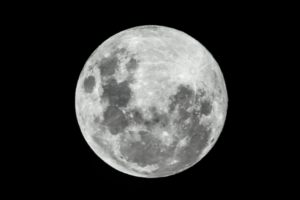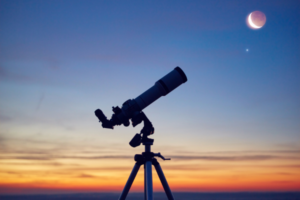How To Collimate A Telescope; Beginner’s Guide
Your Newtonian reflector will give great images of stars and planets — but only as long as you keep it well tuned. The “tuning” of a telescope is known as collimation (also known as alignment). However, this supposed disadvantage can be reduced to a minor task if lining up the optical elements is approached logically and methodically.
Key Takeaways:
- The alignment all components in a telescope to bring light to its best focus is called collimation.
- To collimate a reflector telescope, position the secondary mirror, and align the primary mirror.
- Now fine-tune the alignment of the primary mirror.
Collimation - What is it?
Collimation is the process of aligning all components in a telescope to bring light to its best focus. All telescopes need to be collimated at some point; however, it’s easy to perform this task on some and a bit more involved for others.
Collimation is a lot like routine car maintenance. It isn’t why you bought the car, but you still have to change the oil and check the tire inflation once in a while to keep the vehicle running properly.
You may have heard that collimation is incomprehensible, tedious, time-consuming, a pain in the neck, and best avoided. But the thing to remember is that it doesn’t have to be. Most of the time your scope’s optics can be aligned in a minute or two.
Know Your Reflector
If you aren’t already acquainted with the optical parts of your telescope, now is the time. Here are the components that you will be lining up:
Primary Mirror
This is the paraboloidal mirror at the bottom of the tube. It has an aluminized surface that reflects starlight to form an image at the focal plane. The important thing to know that it has an axis of symmetry — the optical axis.
The primary mirror is held in an adjustable cell designed to support the mirror without deforming it. By adjusting the cell’s collimation screws we can fine-tune the mirror’s tilt and accurately position it where we want it.
Secondary Mirror
This is a small, flat mirror that serves to move the image formed by the primary to the side of the tube, where it is viewed with an eyepiece.
Eyepiece
The third optical component in the telescope system is the eyepiece. It is a complex magnifying lens used to view the image formed at the focal plane.
What are we trying to do?
All we are doing is ensuring that the eyepiece is aimed at the center of the primary mirror, and that the primary is aimed at the centre of the eyepiece. That’s it.
How To Collimate A Reflector Telescope
Newtonians are unique in that you can collimate them with several different methods. Most easy to use are Cheshire collimator or collimator cap ( that you get with your telescope)
Collimation cap: A collimation cap, or sight tube, is a plug that fits in your reflector’s focuser. It has a small central hole. Although it’s mainly used to ensure that your secondary mirror is aligned with respect to your focuser, it can also be used to ensure correct alignment of the secondary and primary mirrors.
Cheshire: This collimator adds a set of crosshairs to a sight tube. Many amateurs I know who own reflectors think a Cheshire is the best way to go in terms of proper collimation.
Collimation is a 3-step process.
Step 1 is to position the secondary mirror.
Step 2 is to align the primary mirror.
Step 3 is to fine-tune the alignment of the primary. Most nights, step #3 is the only one you’ll have to perform.
Step 1: Position the secondary mirror
Look through the focus tube and centre the secondary mirror in the view.
Use the three adjusting screws to roughly align the secondary mirror so that the centre spot of the primary mirror is more or less in the centre of the view.
Now adjust the secondary mirror so that it appears circular when viewed.
Don’t pay any attention to the myriad reflections you can see at this point.
Step 2: Align the primary mirror
Adjust the secondary mirror’s position so that the centre spot on the primary mirror appears central on the crosshairs of a Cheshire eyepiece.
If you have a laser collimator, ensure the laser spot is on the primary mirror’s centre marker.
Ignore the reflection of the secondary in the primary – this gets corrected in step 3.
Step 3: Fine-tune the alignment of the primary
Adjust the position of the primary mirror, using the screws at the rear of the cell, so that the reflections are aligned.
The best tool for this job is a Cheshire eyepiece.
A laser collimator also delivers good results: adjust it so that the return spot is centred on the collimator’s target.
It’s a good idea to carry out this stage at regular intervals to get the most out of your telescope.
Related
How To Collimate A Refractor Telescope
Your refractor includes a collimating eyepiece that can help you to roughly check the alignment of your telescope in the daytime. The collimating eyepiece has a pinhole sight that helps you determine if the optics are properly aligned with the tube.
With the focuser racked in all the way and the diagonal removed, place the collimating eyepiece inside the focuser tube. If the telescope is properly collimated, you should be able to see the entire edge of the objective lens when looking through the pinhole. If the objective lens appears oval, you need to collimate your scope.
Pull off the dew cap at the front of your telescope and look into the scope. The pair of lenses are held in a cell by a threaded ring. This cell is held in place by three pairs of screws spaced 120 degrees apart.
The larger Phillip’s head screws actually hold the cell on, while the smaller, buried Allen screws push against a ledge at the front of the tube and allow the cell to tilt slightly, by tension against the Phillips screws. The idea being to alternately loosen and tighten each against the other until you have a round star image.
There are a number of devices available for collimation. The best one is your eyepiece and the North Star. The easiest way to find the North Star is to look for the Big Dipper. Draw an imaginary line along the two end stars in the bowl of the Big Dipper.
The first star you come to along this line is Polaris. It is best for this purpose that your telescope not be polar aligned, in fact point the mount head due east or west. This is because German Equatorial Mounts have a blind spot
around the pole. Also turn off your motor drive if you have one attached to the mount.
Use your lowest power (largest number eyepiece) to acquire Polaris, centre it using your slow motion controls. Now switch to your next higher power eyepiece, while keeping the image centred.
The in-focus star image will have a bright innermost point, a slightly fainter inner ring and a fainter still outer ring that is hard to see. If it doesn’t look like this, or you can’t reach focus then start with: take out your star diagonal and look at the image slightly out of focus, this will allow you to gauge the deflection. A typical off-collimation image will have a bright spot off to one side when you bring the focus out .
The actual process is to slightly loosen the pair on the side the deflection is, slacken the Allen head screws then tighten the Phillip’s head screws against them again. Check the star image again after moving it into the centre of the eyepiece.
If you find your image getting worse, then go the other way, or slacken the other two Allen screws a little. Once you have a round star image you are set. It helps to have a friend to help for collimation. Have your partner adjust the screws according to your directions while you look in the eyepiece.
How To Collimate A Schmidt-Cassegrain Telescope
Make sure your mount is on and tracking. Insert an eyepiece that will give you moderate to high magnification, and center a fairly bright star, but not the brightest you can see. If you typically observe with a star diagonal, make sure it’s in place. If you’re not using a motorized mount and you’re in the Northern Hemisphere, you can collimate on Polaris.
Defocus slightly until you see a doughnut of light. If your scope is out of collimation, the doughnut’s hole won’t be centered. On the corrector of most modern SCTs, you’ll find a plastic circle, which is the back of the secondary mirror’s mount. There you’ll find three adjustment screws. If you don’t see them, there’s probably a cover to remove.
You’ll need a Phillips screwdriver or an Allen wrench. The screws tend to be small, so be certain to use a tool that fits properly.
We recommend replacing the screws with a set of knobs for safer and easier adjusting. Make small corrections, one screw at a time, look through the eyepiece, and observe the change in the alignment. Continue to adjust these screws until the hole is centered in the doughnut. Once it is, focus a bit more until you can see the diffraction rings, and use them to fine-tune the collimation. Ideally, you should need to adjust only two of the screws. That’s it, done.
ABOUT US
We are a team of active amateur astronomers, here to help you with all your astronomy and science related needs – this is anything, from reviewing the latest telescopes to be released to talking about gravity and neurons. The Big Bang Optics was started because of our love for astronomy and to help others like us find the best telescope and accessories.
LEGAL DISCLAIMER
The Big Bang Optics is a participant in the Amazon Services LLC Associates Program, an affiliate advertising program designed to provide a means for sites to earn advertising fees by advertising and linking to Amazon.com. The Big Bang Optics also participates in affiliate programs with Clickbank and other sites. The Big Bang Optics is compensated for referring traffic and business to these companies.




